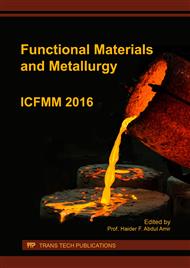p.59
p.67
p.72
p.77
p.85
p.90
p.97
p.103
p.108
Tool Wear of Aluminum/Chromium/Tungsten/Silicon-Based-Coated End Mill Cutters in Milling Hardened Steel
Abstract:
In turning hardened steel, polycrystalline cubic boron nitride (cBN) compacts are widely used, due to their high hardness and high thermal conductivity. However, in milling hardened steel, fracture of cBN cutting tools readily occurs because they have poor fracture toughness. Therefore, coated cemented carbide tools, which have good fracture toughness and wear resistance, are generally and widely used. In this study, hardened steel (ASTM D2, JIS SKD11, 60HRC) was milled with three physical vapor deposition coated cemented carbide end mill cutters in order to determine effective tool materials for milling hardened steel. The coating films used were two types of aluminum/chromium/tungsten/silicon-based-coating films and (Ti,Al)N-coating film. The two types of aluminum/chromium/tungsten/silicon-based-coating films are a new type of coating film, and the Type I and Type II coating film was a two-layered and multi-layered structure, respectively. The following results were obtained: (1) In milling hardened steel at a cutting speed of 2.5 m/s, Type II coating film was the best coating material among the three types of coated film. Type I coating film was superior to (Ti,Al)N-coating film. (2) The critical scratch load of both Type I and Type II of over 130 N became larger than that of the (Ti,Al)N-coating film of 65 N. (3) The multi-layered structure is expected to improve the tool life.
Info:
Periodical:
Pages:
85-89
Citation:
Online since:
September 2017
Authors:
Price:
Сopyright:
© 2017 Trans Tech Publications Ltd. All Rights Reserved
Share:
Citation:


